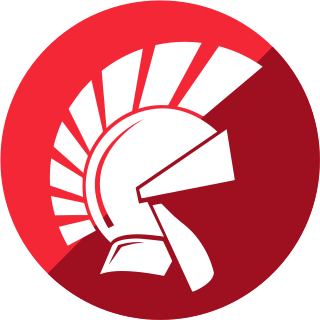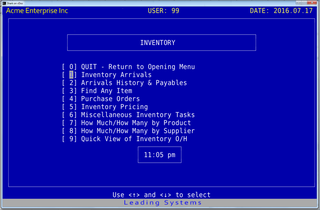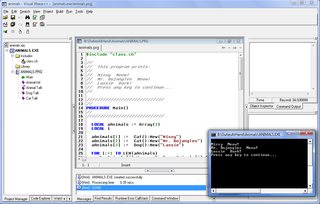In computing, cross-platform software is computer software that is designed to work in several computing platforms. Some cross-platform software requires a separate build for each platform, but some can be directly run on any platform without special preparation, being written in an interpreted language or compiled to portable bytecode for which the interpreters or run-time packages are common or standard components of all supported platforms.
Bytecode is a form of instruction set designed for efficient execution by a software interpreter. Unlike human-readable source code, bytecodes are compact numeric codes, constants, and references that encode the result of compiler parsing and performing semantic analysis of things like type, scope, and nesting depths of program objects.
dBase was one of the first database management systems for microcomputers and the most successful in its day. The dBase system included the core database engine, a query system, a forms engine, and a programming language that tied all of these components together.
A cross compiler is a compiler capable of creating executable code for a platform other than the one on which the compiler is running. For example, a compiler that runs on a PC but generates code that runs on an Android smartphone is a cross compiler.
Ashton-Tate Corporation was a US-based software company best known for developing the popular dBASE database application and later acquiring Framework from the Forefront Corporation and MultiMate from Multimate International. It grew from a small garage-based company to become a multinational corporation. Once one of the "Big Three" software companies, which included Microsoft and Lotus, the company stumbled in the late 1980s and was sold to Borland in September 1991.

Delphi is a general-purpose programming language and a software product that uses the Delphi dialect of the Object Pascal programming language and provides an integrated development environment (IDE) for rapid application development of desktop, mobile, web, and console software, currently developed and maintained by Embarcadero Technologies.
xBase is the generic term for all programming languages that derive from the original dBASE (Ashton-Tate) programming language and database formats. These are sometimes informally known as dBASE "clones". While there was a non-commercial predecessor to the Ashton-Tate product, most clones are based on Ashton-Tate's 1986 dBASE III+ release — scripts written in the dBASE III+ dialect are most likely to run on all the clones.

Free Pascal Compiler (FPC) is a compiler for the closely related programming-language dialects Pascal and Object Pascal. It is free software released under the GNU General Public License, with exception clauses that allow static linking against its runtime libraries and packages for any purpose in combination with any other software license.
Visual Objects is an object-oriented computer programming language that is used to create computer programs that operate primarily under Windows. Although it can be used as a general-purpose programming tool, it is almost exclusively used to create database programs.
Paradox is a relational database management system currently published by Corel Corporation.
Harbour is a computer programming language, primarily used to create database/business programs. It is a modernized, open source and cross-platform version of the older Clipper system, which in turn developed from the dBase database market of the 1980s and 1990s.

C# is a general-purpose high-level programming language supporting multiple paradigms. C# encompasses static typing, strong typing, lexically scoped, imperative, declarative, functional, generic, object-oriented (class-based), and component-oriented programming disciplines.

VP-Info is a database language and compiler for the personal computer. VP-Info was a competitor to the Clipper and dBase applications in the late 1980s and 1990s. VP-Info was originally intended to run on MS-DOS, DR-DOS and the PC-MOS/386 operating system, but now is run in the vDOS, Windows environment. The last release of VP-Info, a multi-tasking, multi-user version released in 1992 was named SharkBase, or simply "Shark".

Xbase++ is an object oriented programming language which has multiple inheritance and polymorphism. It is based on the XBase language dialect and conventions. It is 100% Clipper compatible language supporting multiple inheritance, polymorphism, object oriented programming. It supports the xBase data types, including Codeblocks. With Xbase++ it is possible to generate applications for Windows NT, 95, 98, Me, 2000, XP, VISTA and Windows 7, 8, 10.

Visual Basic (VB) before .NET, sometimes referred to as Classic Visual Basic, is a third-generation programming language, based on BASIC, and an integrated development environment (IDE), from Microsoft for Windows known for supporting rapid application development (RAD) of graphical user interface (GUI) applications, event-driven programming and both consumption and development of components via the Component Object Model (COM) technology.
Basic4ppc is a programming language originally for Pocket PC handheld computers running Windows Mobile operating system, by Anywhere Software. Since 2014, B4x was renamed, and currently, 2023, supports multiple devices and their OS, including desktop and mobile solutions with development adaptions for these environments. The language is based on a BASIC-like syntax, taking advantage of Microsoft's .NET technology, to allow additional libraries, graphical user interface design of windows forms, rapid application development (RAD), and .NET framework compatible compilation. The language implements a unique way of adding objects to a program without being object-oriented. Its advantages are simplicity, development pace and the integration with .NET framework. A special version of the integrated development environment (IDE) allows developing straight onto the Windows Mobile device or. With the demise of Windows Mobile operating system and the devices running it Basic4PPC came to the end of its life in about 2012. For owners of Basic4PPC it remains a useful Windows-desktop BASIC compiler as it runs code directly in the Windows environment and it can compile a project to a Windows 'exe' file for use as a Windows program.

Visual FoxPro is a programming language that was developed by Microsoft. It is a data-centric and procedural programming language with object-oriented programming (OOP) features.
ActiveVFP is a server-side scripting framework designed for Web development to produce dynamic Web pages. Similar to PHP, but using the native Visual Foxpro (VFP) language and database, ActiveVFP can also be used in Model-View-Controller (MVC) web applications as well as RESTful API. ActiveVFP is completely free and open source and does not require the purchase of Microsoft Visual FoxPro or any additional software.






